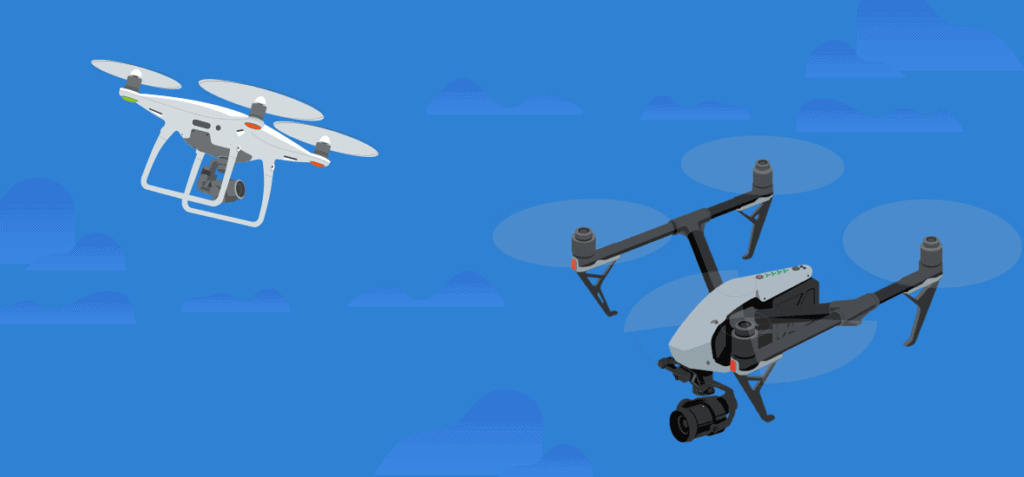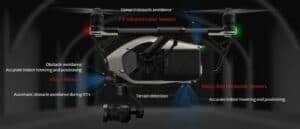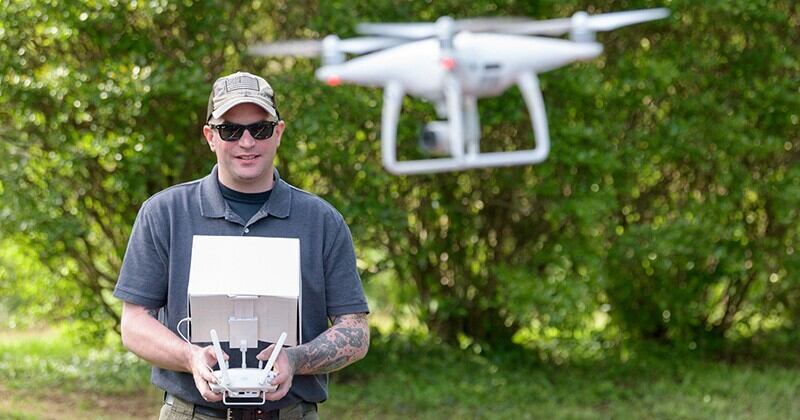What is Collision Avoidance?
The definition of collision avoidance is the ability to avoid colliding with objects in real time. These drones with collision avoidance features have small sensors that are mounted on their body framework.
However, some drones are so advanced that they have optical radar that can see objects in full 360 degrees. Not all drones have the ability to do this and some have limited sensor field of view.
Sensors are a combination of light green to dark green glass-like lenses found on the drone’s body framework.
They act as eyes for the drones using infrared and ultrasonic scans. It is an incredible piece of technology that acts as an additional layer of protection for the drone as well as a remote pilot.
You can find drones with these high-tech sensors on popular brands like DJI, Yuneec, Autel Robotics, and some other drone manufacturers.
These drones with collision avoidance feature usually are bought by professionals and sometimes by beginners who wants to fly them for commercial purposes.
The integration of obstacle avoidance systems helps beginners learn how to fly an advanced drone without making mistakes that easily.

How Does Collision Avoidance Work?
Now, this is the part where I am going to get quite a bit techy with how the whole stuff works.
The obstacle avoidance systems work as detection that automatically collects the data from the drone’s environment.
It sends all the data back to its motherboard using information such as distance to determine how far the objects are.
If the sensors see an object and it is too close for your own drone’s comfort, the processors will tell the drone not to fly closer to it by turning the sensor barred.
As of current, the sensors are designed and built to detect objects as far as 40 feet. It provides you plenty of flying space to maneuver the drone around.
However, we may see improvements to the obstacle avoidance sensors as the technology continue to evolve.
These drones with collision avoidance features have an amazing capability to communicate with the processors.
But without built-in obstacle avoidance detection systems, they won’t be able to see objects and are much more prone to human errors.
After all, you don’t want to accidentally crash a $1,000 drone due to a simple human error, right? That’s what these drones with collision avoidance features are made for beginners!
These built-in sensors are quite potent on their own. They have an amazing capability that allows them to communicate with the “organs” inside the drones.
But, without an obstacle avoidance detection system. The drones will not be able to “see” the objects and are prone to human errors.
After all, nobody wants to crash a $1,000 drone because of a simple human error, right? Here are three types of collision avoidance sensors that you are going to find in the consumer market and how they work:
Types of Collision Avoidance Sensors:
Stereo Vision Sensors For Obstacle Avoidance
Stereo vision works exactly like 3D sensing in the human vision. This vision calculates the depth information by combining two-dimensional images from two cameras to form a different viewpoint.
Which begins by identifying the images that correspond to the same point in a physical scene observed by multiple cameras.
The more corresponding images that are identified, the more 3D points that can be determined with a single set.

The correlation stereo method obtains the corresponding pixels for each image that results in thousands of 3D values with every single image.
DJI drones use this sensor that is located in the front. They also combine the sensors with ultrasonic sensors underneath the drones for precise controls and safe landings.
Ultrasonic Sensors For Detecting Objects (Sonar)
Another popular sensor widely utilized in consumer drones is the Ultrasonic sensor.
This sensor emits a high-frequency pulse that measures the time how it long to takes for the sound to echo back.
The ultrasonic sensor has two openings. One of these transmits ultrasonic waves and the other one receives the ultrasonic wave.
The speed of sound is around 1,100 feet per second in air. Ultrasonic sensors use this information to pass along the difference in time between sending and receiving the sound waves to determine the distance to an object following this mathematical equation:
Distance = Time x Speed of Sound / by 2
- Time = the time between when an ultrasonic wave is transmitted and when it is received
- You divide this number by 2 because the sound wave has to travel to the object and back
The majority of the drones use ultrasonic sensors that are located underneath to help detect the ground as well for tracking terrain in Follow Me mode.
This sensor is also widely utilized in several fields like measuring the distances and objects. Not to forget to mention, it is used in non-destructive methods to test products, structures and detecting invisible flaws.
Proximity Sensors for Obstacle Avoidance (Basic)
Finally, the proximity sensors are one of the most inexpensive and simple features that are commonly added to toy-grade drones.
They aren’t that advanced compared to ultrasonic and stereo vision sensors.
Although, the proximity sensors attempt to mimic in a similar appearance by detecting nearby objects and avoiding them.
Although, the proximity sensors don’t create 3D images in the same way that Stereo Vision sensors do.
Proximity sensors simply detect objects and stop the drone from flying in the flight path. Thereby providing an additional layer of protection to the drones.
As mentioned previously, the proximity sensors are an inexpensive way that enhances the flight safety feature system for beginners and recreational remote pilots.
However, it isn’t widely used in professional-grade camera drones as proximity sensors are not suitable for high-end jobs that require intelligent systems to perform.
Do Drones With Collision Avoidance Make Flying Any Safer?
There are two ways to answer this: yes and no. First of all, the drones that come with collision avoidance features do make flying much safer and easier.
Because these built-in sensors ensure the drone will not collide with objects. Therefore, it minimizes the human pilot’s errors compared to these popular toy-grade drones that are easy to crash.
Another answer to this behind the yes answer: the sensors don’t guarantee protection for your drone.
While the sensors are smart enough to see objects on its own. Some objects are so thin that they are invisible to the sensors.
What happens next if the drone somehow gets caught in a thin wire and briefly goes off balance? These cases would be considered a human error because the remote pilot isn’t paying attention. So you will need to be attentive to the drone’s flight path regardless of how smart the sensors are.
Fortunately, these cases are rare (and getting more rarer as the sensors are being upgraded with better processors and precise mapping).
These smart camera drones make flying much easier and simpler thanks to its ability to project and adjust the optimal flight path without the need of a remote pilot.
This is especially beneficial for businesses and law enforcement agencies.
Why You Should Buy A Drone With An Obstacle Avoidance Feature?
For those who are unsure about buying a drone with an obstacle avoidance feature.
I will be the first one to tell you that having a drone with collision avoidance detection systems function is totally worth investing in.
Even if you have no prior flying experience, you will understand why having a drone with that feature is important.
Most of the toy-grade drones that you see such as the Bolt Bee or Ninja FPV don’t have obstacle avoidance function.
Yet, they are likely to get crash and probably can end up breaking into pieces if you somehow smash them hard enough. They can’t see objects and with a broken drone, you will be a sad drone pilot.
A drone with built-in obstacle avoidance detection prevents simple pilot errors. Not just only that you fly much safer, they extend the service life of the drone.
Typically toy-grade drones acquire damages after a week or two. But with the obstacle avoidance feature, you are looking to fly that drone for at least a few years.
So, basically, your investment is stretching into years rather than weeks.
What Drones with Collision Avoidance Should Buy?
In my experience, it really boils down to your preference and what you have planned to use the drones for.
By all means, the drones with collision avoidance that I listed out are a reputable and great pick. If you are new to drones, then I would recommend you go for DJI Spark. But for those of you who prefer professional drones, Phantom 4 Pro and Inspire 2 both are great picks.

For me personally, my favorite drone with collision avoidance would obviously be the DJI Mavic Pro. It is compact, portable, and small enough to fit in the airplane storage.
I don’t even have to struggle that much when I am traveling around the world. Furthermore, it is one of the popular choices among beginners and professionals alike.
They are used in the business world, not just for travel purposes too.
Likewise, it depends on what you have in your mind. If you are looking to start your own aerial business.
Maybe you want to fly around for fun but also have the capability to capture awesome stills and videos. The high-end professional drones will meet all of your needs.
For beginners, DJI Spark is a safe and affordable option to go with.
These two articles will help you make decisions on what to buy the best drones at affordable prices.
That way you can learn and become comfortable before you plan to buy expensive drones with collision avoidance systems.
As I mentioned previously, the drones with collision avoidance don’t make you automatically an expert pilot.
Any Future Plans Integrating Collision Avoidance for Low-End Drones?
While the obstacle collision avoidance feature is typically restricted to high-end drones such as Mavic 2 Pro or Phantom 4 Pro.
Several low-end drones have already found a solution to address the collision avoidance feature. Although they don’t use the same advanced sensors as more expensive drones do.
In fact, these toy-grade drones have proximity sensors which basically act the same. Instead of intelligently building a 3D map from its surrounding, the proximity sensors detect objects and prevents the drones from flying into them.
Because of how inexpensive and cheap it is to make these sensors, it doesn’t have a lot to offer for the toy-grade drones.
Other than acting as an additional protection layer to the drones. It helps beginners navigate indoor and outdoor safely as much as possible.
While the collision avoidance is definitely a new feature for all of the drones.
It is possible that we will be seeing this feature trickling down into the low-end drones pretty soon once there is a suitable and affordable option to do that delivers the same results.
Eventually, affordable drones will be outfitted with a collision avoidance feature that makes the whole flight experience, even more, easier for beginners.
This will make these drones more popular and appeal a much wider audience who is interested in picking up these quadcopters as their new hobby or simply enjoying flying around once in a while.
Therefore, it is possible that the low-end drones will be integrated with the collision avoidance feature in the future.
Conclusion Drone Owner Recommendations
It is still very likely that you will make mistakes and crash your drones into objects at some point or another.
This is why I strongly recommend that anyone who plans to purchase drones with collision avoidance to have at least some prior experience flying the drones.
That way you are much more familiar with how the drones work. Of course, you still can go ahead and buy a top-end drone right away anyway.

I’ve personally wrecked many drones in the past. Once I took my favorite drone out to the local park with my kids, sent the drone too far away so it lost connection.
While it was returning itself to the ground, it smacked into a tree, the rotors stopped and it did a death spin some 40 feet to the ground.
This snapped off some of the plastic housing, dented the camera and broke one of the blades. It never flew the same after that.
Another time, I was at my office. I had brought my drone to show employees. I flew it off the deck of a 2nd story and made it go around the side of the office.
As it passed around the side of the building, it lost connection. I had to go outside downstairs and outside to find it.
It ultimately smacked up against the side of the building and flipped upside down and fell to the ground where it broke parts of the body off.
It still flew but it looked ugly because of all the cracks and dents. The moral of the story is, this will happen, but having obstacle avoidance lowers the odds.
Most of these drones come in beginner mode enabled when you start flying for the first time.
Which is quite a nice feature in my experience and from the drone owner perspective?
Pilots can learn how the drone flies while getting used to the features that it has. In fact, as your piloting skill grows, your ability to fly the drone safely in the skies will improve.
As I conclude the article about drones with collision avoidance, I hope you find this information helpful and insightful. If you have any questions or thoughts that you want to share with us. Feel free to comment in the comments section below. Happy flying and fly smart!

